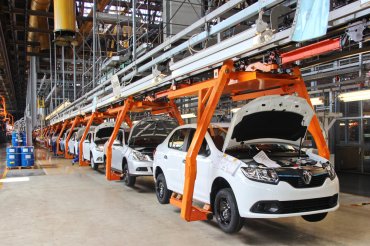Russia exported almost 39,000 new passenger cars in 2017, up 23 percent from the year before, but accounting for just 2.8 percent of the 1.4 million cars produced in the country in the same year, according to Autostat, a consultancy that specializes in the Russian automotive industry.
Countries in the Custom Union (a loose free-trade zone that Russia shares with Kazakhstan, Belarus, Armenia and Kyrgyzstan) are not included as export destinations for Russian-made cars. The main export destinations are the European Union, Central Asia, the countries of the Commonwealth of Independent States and the Middle East.

Photo: Alexander Chizhenok/Shutterstock
Lada and Renault cars on an assembly line in a Togliatti, Russia AvtoVAZ Automobile Plant. Russia exported almost 39,000 new passenger cars in 2017, accounting for just 2.8 percent of the 1.4 million cars produced in the country.
Russian automakers produced 1.4 million units in 2017, up 21 percent from the year before, according to Rosstat, the state statistical department.
In Russia, new passenger car and light commercial vehicle sales grew by 17 percent in the January-July period of this year, compared to the same period in 2017. The trend is expected to remain throughout 2018, but it will have an almost non-existent effect on the passenger car lubricant demand in the country, said Artem Mazaev, an independent consultant in the Russian lubricants industry.
He added that new cars consume much less lubricants [volume] thanks to longer drain intervals. The new cars have drain intervals of 15,000 kilometers, almost double that of cars older than ten years that usually have 8,000 km drain intervals.
In 2017, two models, the Czech Skoda and the Russian Lada, accounted for the largest share of Russian car exports.
Last year, the crossover Skoda Yeti held a 40 percent (15,600 units) share of total passenger car exports from the country. It was followed by Lada, which accounted for 26 percent (10,100 units) of the countrys total exports, and Renault models that held a 10 percent share of exports (3,900 units).
French automobile manufacturer Renault is a majority owner of Avtovaz, the Russian company that produces Lada.
Autostat also found that only 5 percent of the total passenger car exports (or 2,000 units) came from assembly plants operated by Germanys Volkswagen and South Koreas Hyundai in Russia.
According to Renaults annual report for 2017, Germany imported 2,833 units made by Lada. It was followed by Hungary, which imported 1,065 Lada cars, Slovakia (527 units) and the Balkan states (475 units). The Czech Republic and Austria imported 232 cars made by Lada in 2017, while the Baltic states imported 169. In 2017, Belgium and Italy imported 39 and 32 Lada cars, respectively.
Although sales of the new Lada cars in Europe tripled in the last three years, it remains a third of such sales 20 years ago.
According to CarSalesBase.com, only 5,260 new Lada cars were sold in Europe last year, or just 0.03 percent of the EUs total new passenger car sales that amounted to 15.6 million units in 2017. In 1997, Lada sold 14,327 units in Europe, a 0.1 percent share of total European new car sales at that time.